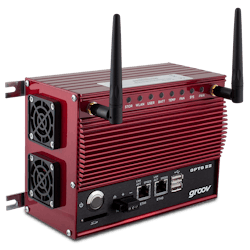Bridging the HMI Terminal/Mobile Gap
The impact of consumer technologies on automation has increased with incredible speed in the past two years. It’s quickly coming to the point where the devices most all of us carry around to browse the Internet, send texts and check up on social media will likely become our principal means of connection to production assets on the shop floor and in the field.
If anything has slowed the speedy evolution of machine-mounted HMI terminals becoming more mobile, it’s been the high software development and IT engineering costs associated with the process. As a result, end users in industry have had to wait for automation suppliers to release mobile versions of their HMIs to remotely control and monitor their production assets from a mobile device.
Opto 22’s release of groov is targeted at dramatically simplifying the process of taking HMI control and monitoring mobile so that end users can do it themselves. To enable this, groov encompasses four key tools inside the groov box, which is an industrially hardened appliance that interfaces with Opto 22 control systems and runs the groov Web application. (Note: Version 1 of groov, which will be officially released on March 13, 2013, interfaces only with Opto 22 systems. Version 2, which is slated for a summer 2013 release, will use OPC UA to connect to any device with an OPC UA driver.) Inside the groov box are:
• groov Build, a Web application mode for creating a groov project (the interface).
• groov View, a Web application mode for running a groov project in any modern web browser.
• And two optional apps to create groov views for iOS and Android devices.
“Opto 22 put a lot of effort into designing groov so that we could put into one box everything you need to develop HMI screens that can be accessed anywhere,” says Benson Hougland, vice president of marketing at Opto 22. “Everything you need to build a mobile, scalable, server-based HMI architecture is in the groov box. And it can be accessed though PCs, smartphones, tablets and even TVs that can access the Web. The only tool required to access and program groov is a Web browser, and it works with all browsers—Internet Explorer, Safari, Firefox, Opera, Chrome, etc.”
Since groov was designed using HTML5, Javascript and SVG (scalable vector graphics), it requires no Flash, Silverlight or Java—which means no plug-ins are required to view the screens created. In addition, when accessing groov from any device, the entire app is downloaded so that screen refresh rates are extremely fast.
Having seen a demonstration of groov, I can say the key to groov’s simplicity in creating views for any environment lies in its development environment—the groov Build app. When you create an HMI screen in groov, you have ability to create the view in a correct orientation for PCs and TVs a well as for smartphones and tablets. This is critical because getting the view you create to adapt properly to the various devices on which it can be viewed has long been the problem with creating screens for multi-device access. It’s the reason so many Web sites’ mobile versions are not very appealing.
With groov, as you design the view for the HMI screen you’ve created, the development environment shows a screen with two tabs. One tab is for devices such as TVs, PCs and tablets and the other tab is for mobile devices. On these tabs you can access the items you want to display on your screen and drag them into the viewing parameters of the device for which you are creating the view. Arranging items within these parameters assures that there will be no issue with the HMI screen displaying correctly on the device you access it with.
Configuration and setup of groov is also very straightforward. If you’ve ever installed a wireless home network router, you’ll be familiar with the groov setup process.
Once the groov box is connected to your system (connection is via Ethernet or WiFi), the groov development environment senses the device tags in your system and populates the groov development environment with the devices you can use to create your HMI screen.
In terms of groov security, Hougland points out that groov is “not a PC, so security doesn't have to be addressed like with a PC.” By using secure sockets layer (SSL) protection, Hougland says groov uses the same security used by banks.
The MSRP for groov is $1995.
Read more about the impact of consumer tech on automation and how HMIs are increasingly going mobile to adapt to modern workforce requirements.
About the Author
David Greenfield, editor in chief
Editor in Chief

Leaders relevant to this article:
